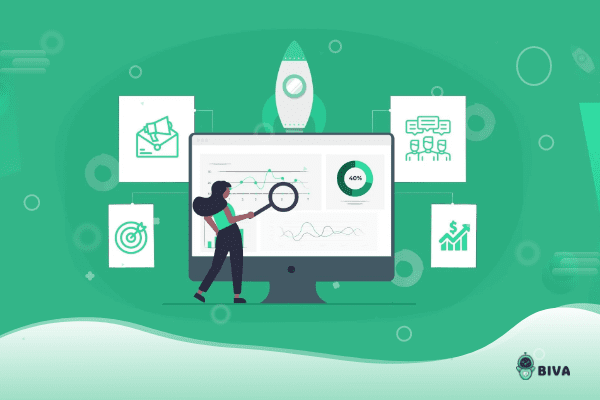
In the ever-evolving landscape of digital marketing, the quest for a competitive edge has led businesses to explore advanced analytics, with Business Intelligence (BI) emerging as a transformative force. BI not only converts raw data into actionable insights but also plays a pivotal role in optimizing marketing campaigns. This comprehensive exploration will delve into the intricate intersection of business intelligence and marketing campaign analytics, covering strategies, challenges, and the profound impact of BI on modern marketing practices.
In the ever-evolving landscape of digital marketing, the quest for a competitive edge has led businesses to explore advanced analytics, with Business Intelligence (BI) emerging as a transformative force. BI not only converts raw data into actionable insights but also plays a pivotal role in optimizing marketing campaigns. This comprehensive exploration will delve into the intricate intersection of business intelligence and marketing campaign analytics, covering strategies, challenges, and the profound impact of BI on modern marketing practices.
Chapter 1: The Dynamic Duo - Unraveling Business Intelligence and Marketing
1.1 Defining Business Intelligence in Marketing
Business Intelligence (BI) involves the use of data analysis tools and techniques to make informed business decisions. In the context of marketing, BI serves as a powerhouse, transforming raw data into actionable insights that drive strategic decision-making. The evolution of marketing analytics has seen a shift from traditional methods to more data-driven approaches, culminating in the integration of BI into marketing strategies.
1.2 The Evolution of Marketing Analytics
Marketing, at its core, has always been about understanding and reaching customers. However, the methods and tools employed have evolved significantly over the years. The advent of digital marketing brought forth a deluge of data, necessitating a shift from traditional methods to more data-driven approaches. This shift paved the way for the integration of business intelligence into marketing strategies.
1.3 The Role of BI in Marketing Campaigns
At its core, BI empowers organizations to harness the wealth of data generated by marketing campaigns. It acts as a guiding force, translating complex datasets into comprehensible insights. The key roles of BI in marketing include data integration, real-time analytics, predictive analytics, and enhanced reporting. These functionalities provide marketers with a comprehensive view of the customer journey and enable agile decision-making.
Chapter 2: Navigating the Challenges of Marketing Campaign Analytics
While the integration of BI into marketing brings a plethora of advantages, it is not without its challenges. Understanding and addressing these hurdles is crucial for organizations seeking to harness the full potential of BI in marketing campaigns.
2.1 Data Silos: Breaking Down the Walls
One of the prominent challenges in BI implementation is the existence of data silos. Different departments or tools often house information independently, hindering the holistic view that BI aims to provide. Breaking down these silos is a prerequisite for accurate and comprehensive marketing analytics.
Solution:
- Develop a comprehensive integration strategy to ensure seamless data flow across departments and tools.
- Implement collaborative platforms that facilitate cross-departmental communication and data sharing.
2.2 Data Quality: Garbage In, Garbage Out
The effectiveness of BI tools hinges on the quality of the data they analyze. Inaccurate or incomplete data can lead to flawed insights, compromising the decision-making process. Establishing robust data quality protocols and conducting regular audits are imperative to maintain the integrity of marketing analytics.
Solution:
- Define and enforce data quality standards across all stages of the data lifecycle.
- Conduct regular audits to identify and rectify inconsistencies or inaccuracies in the dataset.
2.3 Skill Gap: Bridging the Expertise Divide
Unlocking the full potential of BI tools demands a certain level of expertise. Organizations may face challenges in finding or developing talent with the necessary skills to navigate and leverage BI effectively. Continuous training and upskilling initiatives are essential to bridge the expertise gap and empower marketing teams.
Solution:
- Invest in comprehensive training programs to equip marketing and analytics teams with the skills needed to navigate BI tools.
- Foster a culture of continuous learning to stay abreast of new features and best practices.
2.4 Implementation Complexity: Navigating the Integration Maze
The integration of BI tools can be a complex process, especially for organizations with legacy systems or diverse data sources. Careful planning, collaboration between IT and marketing teams, and phased implementation can mitigate these complexities and ensure a smooth integration process.
Solution:
- Develop a comprehensive implementation plan that outlines the integration process, timelines, and milestones.
- Implement BI tools in phases, starting with essential functionalities and gradually expanding the scope.
Chapter 3: Strategies for Effective BI in Marketing Campaigns
To harness the full potential of business intelligence in marketing campaigns, organizations can implement a range of strategies. These strategies not only address challenges but also lay the groundwork for a robust and effective BI framework.
3.1 Define Clear Objectives: Charting the Course
The first step in any successful BI implementation is to define clear objectives. What specific insights are you seeking from your marketing campaigns? Knowing your goals will guide the selection and configuration of BI tools to align with your organizational objectives.
Implementation:
- Conduct a thorough analysis of your marketing objectives and align them with the capabilities of BI tools.
- Clearly define key performance indicators (KPIs) that will serve as benchmarks for the success of your marketing campaigns.
3.2 Integrate Data Sources: Creating a Unified Front
The power of BI lies in its ability to consolidate data from various sources. Ensure that your BI tool can seamlessly pull in data from social media platforms, email marketing tools, website analytics, and CRM systems. A unified data front provides a comprehensive view of customer interactions and behaviors.
Solution:
- Identify all relevant data sources within your organization.
- Select BI tools that support integration with diverse data sources.
- Develop a robust data integration strategy to ensure a seamless flow of information.
3.3 Ensure Data Quality: The Foundation of BI
Data quality is non-negotiable in the world of BI. Establishing data quality standards and regularly auditing datasets are critical steps to ensure the accuracy and reliability of the insights derived from BI tools.
Solution:
- Develop and communicate clear data quality standards across the organization.
- Implement regular audits and checks to identify and rectify any inconsistencies or inaccuracies in the dataset.
3.4 Invest in Training: Empowering Your Teams
BI tools are only as effective as the teams using them. Provide comprehensive training to marketing and analytics teams to ensure they have the skills to navigate and leverage BI tools effectively. A well-trained team is a key asset in maximizing the value of BI in marketing campaigns.
Solution:
- Identify specific training needs for your teams based on the functionalities of the chosen BI tools.
- Provide ongoing training opportunities to keep teams updated on new features and best practices.
3.5 Embrace Scalability: Future-Proofing Your BI Implementation
Choose BI tools that can scale with your organization's growth. Scalability is crucial as data volumes and analytics requirements evolve over time. Future-proofing your BI implementation ensures that it remains effective and relevant as your organization expands.
Solution:
- Evaluate the scalability of BI tools before implementation.
- Choose tools that can accommodate growing data volumes and evolving analytics needs.
3.6 Foster Collaboration: A Cross-functional Approach
BI implementation is not the sole responsibility of the marketing team. Encourage collaboration between marketing, IT, and data analytics teams. A cross-functional approach ensures that everyone is aligned on objectives and can contribute to the success of BI initiatives.
Solution:
- Establish regular communication channels between marketing, IT, and data analytics teams.
- Encourage a collaborative culture where insights and feedback are shared across departments.
3.7 Utilize Predictive Analytics: Anticipating the Future
Leverage the predictive analytics capabilities of BI tools to anticipate trends and customer behavior. Predictive analytics provides valuable foresight that empowers marketers to proactively adjust strategies and capitalize on emerging opportunities.
Solution:
- Explore and implement the predictive analytics functionalities of your chosen BI tools.
- Use predictive insights to inform marketing strategies, resource allocation, and campaign optimization.
3.8 Implement Real-time Monitoring: Agility in Action
Embrace real-time analytics for continuous monitoring of campaign performance. Real-time insights empower marketers to make timely adjustments, seize opportunities, and address challenges as they arise. The ability to monitor campaigns in real-time enhances agility and responsiveness.
Solution:
- Integrate real-time analytics capabilities into your BI framework.
- Establish protocols for real-time monitoring and decision-making during active marketing campaigns.
Conclusion
In conclusion, the integration of business intelligence into marketing campaigns marks a paradigm shift in the way organizations approach data-driven decision-making. While challenges such as data silos, data quality, skill gaps, and implementation complexities may arise, strategic planning and the adoption of best practices can pave the way for successful BI implementation.
By defining clear objectives, integrating data sources, ensuring data quality, investing in training, embracing scalability, fostering collaboration, utilizing predictive analytics, and implementing real-time monitoring, organizations can unlock the full potential of BI in their marketing endeavors.
The strategies outlined provide a roadmap for organizations to navigate the challenges and leverage BI as a powerful tool for transforming marketing campaigns.
1.1 Defining Business Intelligence in Marketing
Business Intelligence (BI) involves the use of data analysis tools and techniques to make informed business decisions. In the context of marketing, BI serves as a powerhouse, transforming raw data into actionable insights that drive strategic decision-making. The evolution of marketing analytics has seen a shift from traditional methods to more data-driven approaches, culminating in the integration of BI into marketing strategies.
1.2 The Evolution of Marketing Analytics
Marketing, at its core, has always been about understanding and reaching customers. However, the methods and tools employed have evolved significantly over the years. The advent of digital marketing brought forth a deluge of data, necessitating a shift from traditional methods to more data-driven approaches. This shift paved the way for the integration of business intelligence into marketing strategies.
1.3 The Role of BI in Marketing Campaigns
At its core, BI empowers organizations to harness the wealth of data generated by marketing campaigns. It acts as a guiding force, translating complex datasets into comprehensible insights. The key roles of BI in marketing include data integration, real-time analytics, predictive analytics, and enhanced reporting. These functionalities provide marketers with a comprehensive view of the customer journey and enable agile decision-making.
Chapter 2: Navigating the Challenges of Marketing Campaign Analytics
While the integration of BI into marketing brings a plethora of advantages, it is not without its challenges. Understanding and addressing these hurdles is crucial for organizations seeking to harness the full potential of BI in marketing campaigns.
2.1 Data Silos: Breaking Down the Walls
One of the prominent challenges in BI implementation is the existence of data silos. Different departments or tools often house information independently, hindering the holistic view that BI aims to provide. Breaking down these silos is a prerequisite for accurate and comprehensive marketing analytics.
Solution:
- Develop a comprehensive integration strategy to ensure seamless data flow across departments and tools.
- Implement collaborative platforms that facilitate cross-departmental communication and data sharing.
The effectiveness of BI tools hinges on the quality of the data they analyze. Inaccurate or incomplete data can lead to flawed insights, compromising the decision-making process. Establishing robust data quality protocols and conducting regular audits are imperative to maintain the integrity of marketing analytics.
Solution:
- Define and enforce data quality standards across all stages of the data lifecycle.
- Conduct regular audits to identify and rectify inconsistencies or inaccuracies in the dataset.
Unlocking the full potential of BI tools demands a certain level of expertise. Organizations may face challenges in finding or developing talent with the necessary skills to navigate and leverage BI effectively. Continuous training and upskilling initiatives are essential to bridge the expertise gap and empower marketing teams.
Solution:
- Invest in comprehensive training programs to equip marketing and analytics teams with the skills needed to navigate BI tools.
- Foster a culture of continuous learning to stay abreast of new features and best practices.
The integration of BI tools can be a complex process, especially for organizations with legacy systems or diverse data sources. Careful planning, collaboration between IT and marketing teams, and phased implementation can mitigate these complexities and ensure a smooth integration process.
Solution:
- Develop a comprehensive implementation plan that outlines the integration process, timelines, and milestones.
- Implement BI tools in phases, starting with essential functionalities and gradually expanding the scope.
To harness the full potential of business intelligence in marketing campaigns, organizations can implement a range of strategies. These strategies not only address challenges but also lay the groundwork for a robust and effective BI framework.
3.1 Define Clear Objectives: Charting the Course
The first step in any successful BI implementation is to define clear objectives. What specific insights are you seeking from your marketing campaigns? Knowing your goals will guide the selection and configuration of BI tools to align with your organizational objectives.
Implementation:
- Conduct a thorough analysis of your marketing objectives and align them with the capabilities of BI tools.
- Clearly define key performance indicators (KPIs) that will serve as benchmarks for the success of your marketing campaigns.
The power of BI lies in its ability to consolidate data from various sources. Ensure that your BI tool can seamlessly pull in data from social media platforms, email marketing tools, website analytics, and CRM systems. A unified data front provides a comprehensive view of customer interactions and behaviors.
Solution:
- Identify all relevant data sources within your organization.
- Select BI tools that support integration with diverse data sources.
- Develop a robust data integration strategy to ensure a seamless flow of information.
Data quality is non-negotiable in the world of BI. Establishing data quality standards and regularly auditing datasets are critical steps to ensure the accuracy and reliability of the insights derived from BI tools.
Solution:
- Develop and communicate clear data quality standards across the organization.
- Implement regular audits and checks to identify and rectify any inconsistencies or inaccuracies in the dataset.
BI tools are only as effective as the teams using them. Provide comprehensive training to marketing and analytics teams to ensure they have the skills to navigate and leverage BI tools effectively. A well-trained team is a key asset in maximizing the value of BI in marketing campaigns.
Solution:
- Identify specific training needs for your teams based on the functionalities of the chosen BI tools.
- Provide ongoing training opportunities to keep teams updated on new features and best practices.
Choose BI tools that can scale with your organization's growth. Scalability is crucial as data volumes and analytics requirements evolve over time. Future-proofing your BI implementation ensures that it remains effective and relevant as your organization expands.
Solution:
- Evaluate the scalability of BI tools before implementation.
- Choose tools that can accommodate growing data volumes and evolving analytics needs.
BI implementation is not the sole responsibility of the marketing team. Encourage collaboration between marketing, IT, and data analytics teams. A cross-functional approach ensures that everyone is aligned on objectives and can contribute to the success of BI initiatives.
Solution:
- Establish regular communication channels between marketing, IT, and data analytics teams.
- Encourage a collaborative culture where insights and feedback are shared across departments.
Leverage the predictive analytics capabilities of BI tools to anticipate trends and customer behavior. Predictive analytics provides valuable foresight that empowers marketers to proactively adjust strategies and capitalize on emerging opportunities.
Solution:
- Explore and implement the predictive analytics functionalities of your chosen BI tools.
- Use predictive insights to inform marketing strategies, resource allocation, and campaign optimization.
Embrace real-time analytics for continuous monitoring of campaign performance. Real-time insights empower marketers to make timely adjustments, seize opportunities, and address challenges as they arise. The ability to monitor campaigns in real-time enhances agility and responsiveness.
Solution:
- Integrate real-time analytics capabilities into your BI framework.
- Establish protocols for real-time monitoring and decision-making during active marketing campaigns.
In conclusion, the integration of business intelligence into marketing campaigns marks a paradigm shift in the way organizations approach data-driven decision-making. While challenges such as data silos, data quality, skill gaps, and implementation complexities may arise, strategic planning and the adoption of best practices can pave the way for successful BI implementation.
By defining clear objectives, integrating data sources, ensuring data quality, investing in training, embracing scalability, fostering collaboration, utilizing predictive analytics, and implementing real-time monitoring, organizations can unlock the full potential of BI in their marketing endeavors.
The strategies outlined provide a roadmap for organizations to navigate the challenges and leverage BI as a powerful tool for transforming marketing campaigns.
Thank you for exploring the comprehensive guide on Business Intelligence's transformative role in marketing campaigns. We trust that the strategies and insights shared will empower your marketing endeavors. As you embark on implementing BI in your campaigns, may you navigate with clarity, leverage data-driven decisions, and witness the success of your efforts. Here's to a future of data-driven marketing excellence! Cheers to your continued success.
Thank you for exploring the comprehensive guide on Business Intelligence's transformative role in marketing campaigns. We trust that the strategies and insights shared will empower your marketing endeavors. As you embark on implementing BI in your campaigns, may you navigate with clarity, leverage data-driven decisions, and witness the success of your efforts. Here's to a future of data-driven marketing excellence! Cheers to your continued success.
Related Posts
Product Foundations



